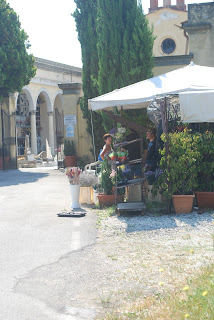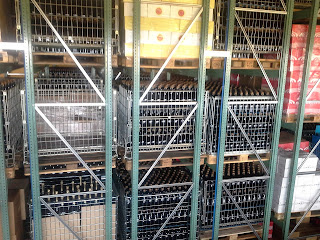Back to Elena, she has a close
cooperation with the University in Pisa and their agricultural department. Her
winery soil has created good quality with award winning wines. In addition she
has a passion for the ecological production system that we see more and more of
in this area.
Even with 15 ha with land se
produce 7 types of wine. Indication she produce average 10000 bottles per type
of wine. She has 3 type of White, 1 Rose, 2 Red and one desert Red.
We tasted it all. I.G.T.
Chardonnay of Tuscany obtained from Chardonnay and White Pinot produced in a
wine yard called “Verruka”. Its grapes are separately made at low temperature
and later mixed up. Refined in Stainless Steel tanks before bottled, straw-yellow
color, a fresh and sapid flavor and smell you can enjoy a fruity aroma. Perfect
together with fish and shellfish
White Montecarlo is obtained from
Trebbiano, Pinot Bianco, Vermentino, Sauvignon, Semillon and Roussane grapes. This
also vinified in SS tanks, at low temperature this in order to keep the typical
flavors belonging to these wines, full bright straw-yellow color beside its
fruity and flowery bouquet, delicate and characteristic together with a dry and
harmonious taste. Good match with white meat dishes.
Her last white is called URANO. This
wine is the result of pure Sauvignon grapes cultivated in the coolest and
airiest vineyards of the entire winery. It is a bright straw-yellow wine. From
the characteristic fruity flavor rich of grapefruit and citron notes, fresh and
tasty in the mouth and perfect with fish.
Her Rose wine “Kapogiro” is a
brand new bland she did not want to tell too much about yet. Never the less it
was this Rose we fell in love with this summer. It had the fruity and flowery
bouquet. A medium plus pink color, and it was dry as we like it. Not a too
strong after taste, but a touch into sweetness after some time that make it
dangerous to leave at a table on a warm summer night. We tasted it with several
fish and shellfish dishes and it was a complete match.
We also brought back to Moscow a
bottle of her ALEATICO, her desert wine. Not a port, but could be enjoyed like
one and I am quite pleased to have this for the winter evenings.
This professional winemaker did
not have a professional area for wine tasting. It was done in a local Italian farmer’s
way, both the tasting and the dinner in her garden. The food at the dinner she
had invited in a chef from Viareggio with years of practice for fish and
seafood dishes. And it gave us the best summer experience we could have. Get to
know local wine we would not have experienced unless by coincident which is the
best way to find great stuff.
To compare this with the experience
of the Montecarlo best wine tasting place at
“Buonamico” is difficult. Wine
tasting is based on what you like and not what people say. We got back bottles
from Buonamico too, red and white. The Spumante we could not wait to drink so
that we enjoyed already in Italy.
In order to further improve his wines, Giulio Magnani, an
enlightened and passionate winemaker from Montecarlo and proprietor of the
Marchi-Magnani farming estate, left for France around the year 1870 to study
the grape varieties and winemaking techniques of our cousins beyond the Alps,
who at that time were already producing wines that were highly valued even well
beyond their borders. He ended up in the Bordeaux region and later brought
Sauvignon, Semillon, Merlot, Cabernet Franc and Cabernet Sauvignon grapes back
with him to Montecarlo. He also acquired Roussanne and Syrah grapes while
travelling through the Rhone region, as well as white and gray Pinot grapes
from the Burgundy region.
Upon returning home, he began experimenting by adding various
percentages of these new varieties to the Trebbiano wine in order to render it
more elegant, smooth and fragrant.
From that time forward, the Montecarlo wine states began
producing high quality wines, which are recognized as such both nationally and
internationally.
The wines of Montecarlo soon became highly sought after by some
of the most illustrious personalities of the time, to the point that they were
even found at Prince Umberto of Savoy’s wedding to Maria Josè at the Quirinal
Palace in 1930. At that time, the wines produced by the Marchi Magnani estate,
as well as those of other producers, including the Pucci, Carrara, Pardocchi,
De Dominicis estates, won numerous awards in Italy as well as abroad. Back
then, the wine was known by everyone as “The Chablis of Montecarlo”.
Significant investments were immediately made to further improve
the quality of the wines produced on the new property, which belongs to the Fontana
family.
The property extends over 40 hectares, 26 of which are employed
in the production of red and white grapes. With a three-year program of
planting on the vacant land, which began in the spring of 2009 and ended in the
spring of 2011, the total wine growing area has reached a total of 38 hectares.
During this time frame, a number of the older and less
productive vineyards were replaced with new plantations of higher density per
hectare. The new grapevines are exclusively derived from noble strains,
including white grapes such as Sauvignon Blanc, Chardonnay, Vermentino and
Viogner, and red grape varieties such as Sangiovese Syrah and Canaiolo. An
experimental vineyard of the Canaiolo Rosa and Buonamico varieties has been
created in order to monitor the development of the vines over time and to
maintain a heritage of these two types of grape varieties, which has almost
entirely disappeared on a national level, with the ultimate goal of using them
for the Estate’s rosé wine.
The latest development in the cellar, on the other hand, is the
presence of winemaker Alberto Antonini, with whom a multi-year development
program is shared, aimed at improving the quality of the wines already present,
while keeping a keen eye on the trends expected from the market.
The estate’s new look is being coordinated by architect Paolo
Riani, who is following the entire process of its restructuring.
In addition to a brand new wine-tasting room for hosting the
increasing number of visitors interested in finding out more about the wines
produced upon the estate, the charming and historic wine cellar known as
“l’inferno” has also been renovated, where guests can enjoy our winery’s rich
history of winemaking, from the first bottle dating back to 1964, to the latest
vintage. For those who are interested in discovering the place behind this
intriguing name, the wine cellar is even equipped with a number of interesting
vertical display cases.
In order to be able to accommodate all the grapes that will be
grown using the new plantations, with the new plantations and the old
re-planted terrains reaching a total of nearly 12 hectares, the winery’s
production facilities will undergo a significant structural expansion of 500
square meters, while leaving the current layout, surrounded by lush greenery,
unaltered.
What’s more, the winery will also be equipped with the best
winemaking, bottling and storage equipment.
Since the volume of the reserves will also increase over the
years, the “barriccia” will also be expanded and will be built in an ad hoc
environment, where the wines can rest undisturbed, save for the occasional
visitors.
An area has even been dedicated to the aging of the reserve
wines, with a special temperature-controlled and thoroughly dehumidified
environment.
With the investments that have already been made and those which
are foreseen for the near future, the company’s objective is to quickly obtain
wines of the utmost quality, with maximum respect for the land and with an open
mind to any new developments in wine-making techniques.
I have already mentioned that we fall in love with the Spumante
Particolare as we were served this wine the first Sunday in Montecarlo with our
first dinner there. Rosé and
sparkling wine vinification according to the Charmat method: the sparkling wine
vinification process is carried out in an autoclave at a constantly monitored
temperature, where the select yeasts provide for optimal fermentation. Once the
fermentation time of approximately 120 days has been completed, the product is
immediate filtered in order to preserve its natural freshness. The final
bottling stage is carried out after the product has been left to age for
several weeks in an autoclave. The wine is then left to age in the bottle for
an additional 4 months. The result I know will be more bottles at our home next
year. The dry wine made from Sangiovese and Syrah grapes is complete and could
give a change to our love for Prosecco.

We brought home two other wines, one was the Il Fortino Syrah.
In 2009 Wine Spectator gave it 94 points and I can understand. What we tasted
was maybe a bit younger wine, but very enjoyable. It is a 100% SYRAH, Fermentation in stainless steel
and ageing in French Oak barrels for about 18 months. Intense, full-bodied,
with red fruits mixed with vanilla and spices (pepper and liquorice). Very full-bodied, fruity, balanced, with a great structure. It fit
Grilled red and white meat with or without sauces, delicate roast meat.
The other
was a white, VASARIO 100% White Pinot. Yellow with golden reflexes, very
intense, complex, with flowers and fruits mixed with spices, wide, well
structured, very balanced, with a soft and persistent end, shellfishes with
light sauce, roast fishes or baked in foil, white meat, light sauce.
It has to be said that Buonamico is a professional wine
tasting wine yard. If you pass by between 8 a.m. and 8 p.m. you will be taken
care of for tasting of either 4 white, 4 red or both alternatives. If you would
like a tour at the facility as well you should give them a call in advance. I
know they have a great guide with great stories to tell. In addition make a
lunch, it gives you more time for wine tasting and time to think of what to
bring back home or shipped.
I can just say we had some great time visit these two wine
yards. Look forward to find out more about the other in our neighborhood.



















































